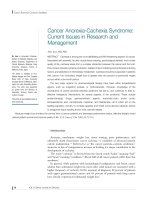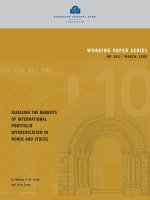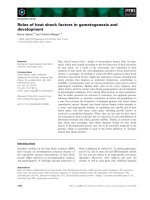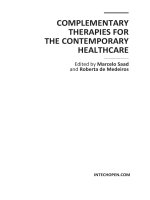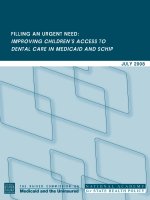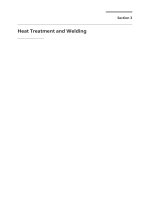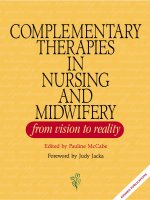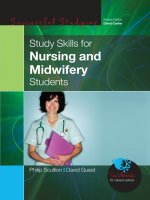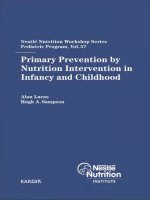Complementary Therapies in Nursing and Midwifery ppt
Bạn đang xem bản rút gọn của tài liệu. Xem và tải ngay bản đầy đủ của tài liệu tại đây (2.65 MB, 338 trang )
aromatherapy massage relaxation guided imagery music meditation hydrotherapy therapeutic touch
healing touch nutritionaromatherapy massage relaxation guided imagery music meditation hydrotherapy
herapeutic touch healing touch nutritionaromatherapy massage relaxation guided imagery music
meditation hydrotherapy therapeutic touch healing touch nutritionaromatherapy massage relaxation guided
magery music meditation hydrotherapy therapeutic touch healing touch nutritionaromatherapy massage
elaxation guided imagery music meditation hydrotherapy therapeutic touch healing touch
nutritionaromatherapy massage relaxation guided imagery music meditation hydrotherapy therapeutic
ouch healing touch nutritionaromatherapy massage relaxation guided imagery music meditation
hydrotherapy therapeutic touch healing touch nutritionaromatherapy massage relaxation guided imagery
music meditation hydrotherapy therapeutic touch healing touch nutritionaromatherapy massage relaxation
guided imagery music meditation hydrotherapy therapeutic touch healing touch nutritionaromatherapy
massage relaxation guided imagery music meditation hydrotherapy therapeutic touch healing touch
nutritionaromatherapy massage relaxation guided imagery music meditation hydrotherapy therapeutic
ouch healing touch nutritionaromatherapy massage relaxation guided imagery music meditation
hydrotherapy therapeutic touch healing touch nutritionaromatherapy massage relaxation guided imagery
music meditation hydrotherapy therapeutic touch healing touch nutritionaromatherapy massage relaxation
guided imagery music meditation hydrotherapy therapeutic touch healing touch nutritionaromatherapy
massage relaxation guided imagery music meditation hydrotherapy therapeutic touch healing touch
nutritionaromatherapy massage relaxation guided imagery music meditation hydrotherapy therapeutic
ouch healing touch nutritionaromatherapy massage relaxation guided imagery music meditation
hydrotherapy therapeutic touch healing touch nutritionaromatherapy massage relaxation guided imagery
music meditation hydrotherapy therapeutic touch healing touch nutritionaromatherapy massage relaxation
guided imagery music meditation hydrotherapy therapeutic touch healing touch nutritionaromatherapy
massage relaxation guided imagery music meditation hydrotherapy therapeutic touch healing touch
triti r th r p ss r l ti id d i r si dit ti h dr th r p th r p ti
Edited by Pauline McCabe
Foreword by Judy Jacka
Throughout history human beings have turned to natural means
for treating illness. At the beginning of the third millennium,
when medical knowledge has never been stronger, the interest in
natural therapies continues to rise.
The therapies described in this book include nutrition,
aromatherapy, relaxation techniques, music therapy, pet therapy,
therapeutic touch and massage. They can be used in nursing
practice to induce relaxation, help create a healing environment,
increase comfort, reduce pain and address troublesome
symptoms, but they also have a role in empowering both nurses
and patients to maintain their own health. Also significant is the
improved professional satisfaction that often accompanies
advanced nursing practice in complementary care.
Pauline McCabe, known widely among Australian nurses and
midwives for her skill and experience in the practice of
complementary therapies, has gathered together a talented group
of practitioners to write passionately about their particular
specialties and experiences. All nurses and midwives will benefit
from reading what these authors have to say.
Pauline McCabe is currently Senior
Lecturer in Naturopathy at La Trobe
University in Victoria, Australia. She
brings to the editorship of this book
over three decades of experience as a
nurse-naturopath, and a career that has
made significant contributions to the
AUSMED PUBLICATIONS
C
integration of complementary therapies into Australian nursing
practice. Pauline strongly believes that the use of
complementary therapies by nurses will significantly advance
the practice, theory, and professional development of
nursing in the coming years.
ISBN 0 9577988 1 4
from vision to reality
COMPLEMENTARY
THERAPIES
IN
NURSING
AND
MIDWIFERY
AUSMED PUBLICATIONS
COMPLEMENTARY THERAPIES
IN NURSING & MIDWIFERY
from vision to reality
Complementary Therapies
in Nursing and Midwifery
from vision to practice
i
Chapter Three
Other titles published by Ausmed Publications
Ageing at Home: Practical Approaches to Community Care
Edited by Theresa Cluning
Keeping in Touch with someone who has Alzheimer’s
Jane Crisp
Geriatric Medicine, 2nd edn
Len Gray, Michael Woodward, Ron Scholes,Wendy Busby, David Fonda
The Midwife and the Bereaved Family
Jane Warland
Living in a New Country: Understanding Migrants’ Health
Edited by Pranee Liamputtong Rice
Palliative Care Nursing: A Guide to Practice
Edited by Sanchia Aranda and Margaret O’Connor
Caring for the Person with Faecal Incontinence
Karen Cavarra,Andrea Prentice and Cynthea Wellings
Revised by Janette Williams
Practical Approaches to Infection Control in Residential Aged Care
Kevin J. Kendall
Promoting Men’s Health
Edited by Tom Laws
Nursing the Person with Cancer
Edited by Gordon Poulton
Nursing Documentation: writing what we do
Edited by Jennifer Richmond
Spirituality: The Heart of Nursing
Edited by Professor Susan Ronaldson
Rethinking Dementia — an Australian approach
Edited by Sally Garratt and Elery Hamilton-Smith
Thinking Management: Focusing on People
Edited by Jean Anderson
Caring for People with Problem Behaviours, 2nd edition
Bernadette Keane and Carolyn Dixon
Asian Mothers, Western Birth
Edited by Pranee Liamputtong Rice
Unique and Ordinary: Reflections on Living and Dying in a Nursing Home
Rosalie Hudson and Jennifer Richmond
COMPLEMENTARY THERAPIES IN NURSING AND MIDWIFERY
ii
Complementary Therapies in
Nursing and Midwifery
from vision to practice
Edited by
PAULINE McCABE
Foreword by
JUDY JACKA
Ausmed Publications
Melbourne
iii
Chapter Three
Australasian Health Education Systems Pty Ltd
(ACN 005 611 626)
trading as
Ausmed Publications
277 Mount Alexander Road
ASCOT VALE,VICTORIA 3032,AUSTRALIA
© Ausmed Publications March 2001
First published March 2001
All Rights Reserved.Without limiting the rights under copyright reserved above, no part of this
publication may be reproduced, stored in or introduced into a retrieval system, or transmitted, in
any form or by any means (electronic, mechanical, photocopying, recording or otherwise), without
the written permission of Ausmed Publications. Requests and inquiries concerning reproduction
and rights should be addressed to the Manager,Ausmed Publications, PO Box 4086, Melbourne
University,Victoria 3010,Australia.
Further copies of this book and of all other Ausmed publications are available from the
Distribution Manager,Ausmed Publications, PO Box 4086, Melbourne University,Victoria 3010,
Australia.
Telephone +61 3 9375 7311.
Fax +61 3 9375 7299.
Home page www.ausmed.com.au
National Library of Australia Cataloguing-in-Publication data:
Complementary therapies in nursing and midwifery : from vision to practice.
Includes index
ISBN 0 9577988 1 4
1.Alternative medicine. 2. Nursing. 3. Midwifery. I. McCabe, Pauline. II.
Jacka, Judy, 1938
610.73
Edited by Trisha Dunning
Cover, design, typesetting and printing by Hyde Park Press, 5 Deacon Avenue, Richmond,
South Australia 5033, telephone (08) 8234 2044, fax (08) 8234 1887, e-mail
Text set in 10/14 Garamond Book
COMPLEMENTARY THERAPIES IN NURSING AND MIDWIFERY
iv
Foreword
This is an exciting and timely book. It describes how nurses are pioneering
complementary therapies within the medical system to give comfort and healing to
their patients. It is 40 years since I graduated from general nursing training at Prince
Henry’s Hospital Melbourne with deep disappointment about the medical model of
1960. Perhaps my greatest concern was that nurses had insufficient opportunity and
resources to give true caring to their patients.At that time there was little information
about alternative medicine and healing in Australia, but my own quest gradually unfolded
to include a world of healing that I experienced as truly remarkable. My goal became to
create education that would combine natural therapies with a suitable standard of
orthodox science and medicine. In 1997 the Victorian government accredited the
Bachelor Degree in Health Science (Naturopathy) delivered by the Southern School of
Natural Therapies, making it the first private college in Victoria to offer a government
accredited complementary therapy course.
Therefore, during the last 30 years I have been intimately involved with practising
natural therapies and the task of developing a degree standard course for training in the
area.Throughout the 1980s many hundreds of nurses attended courses I conducted in
natural therapies for the Council of Adult Education in Melbourne. Some of those nurses
later enrolled to undertake training at our school. Indeed, since the birth of the school in
1961, nurses have featured strongly amongst our students and they have become
excellent primary contact practitioners.
However, this book features nursing as a profession studying and developing research
and guidelines about natural therapies that enhance nursing practice and improve
patient care in a medical setting. It is now evident that nurses as a professional group
want to know how to apply natural therapies to augment and improve the health of
their patients within the current medical model. So, for me, this is an exciting book,
because I now witness the educational and practice opportunities for complementary
therapies that are taking place within the nursing profession. Perhaps this development
will in time have powerful repercussions on the whole health care system. In a
personal sense, my observations have come full circle, from those of a disillusioned
graduate nurse, to observations of nurses creating opportunities to practise their own
healing therapies.
v
Chapter Three
While preparing to write this foreword it occurred to me that rarely have I heard much
criticism directed towards nurses as a group, despite hearing harsh criticism of
orthodox medicine from various directions.The nursing profession appears to have
always created the perception of being a caring group that did the best for its patients
despite all kinds of difficulties and challenges. It is, therefore, understandable that nurses
are endeavouring to extend their practices to encompass therapies that they perceive as
promoting a more human touch for their patients. In addition, research into the
practices and therapies described in this book has demonstrated improved clinical
outcomes in many of the patients concerned.
The book covers a wide range of areas that includes an historical perspective of natural
therapies within the nursing profession; legal and ethical considerations; research
possibilities and achievements; and educational considerations, as well as the pioneering
experiences of nurses in areas such as nutrition, aromatherapy, massage, meditation,
holistic coronary care, music therapy and the use of pet animals.The practice of
complementary therapies within midwifery is an exciting development and what better
way to give a child a peaceful start in life?
It is of interest that the term ‘complementary therapies’ rather than ‘natural therapies’
is used throughout the book. Educational and government committees dealing with
such therapies have always been challenged to find the most appropriate label and
definition of these healing arts and sciences.The therapies explored in this book are
certainly those that can be seen to complement, rather than threaten orthodox
medical practice. Hospital management could consider massage, aromatherapy,
music and meditation as safe options compared, for instance, to the use of herbs
and homeopathy.
I will be interested to observe how graduates from the double degree in nursing and
naturopathy at Latrobe University and similar courses apply their training in herbal
medicine and homeopathy in the workplace. Some authorities may view oral therapies
as contradicting the use of pharmaceutical drugs. I look forward to a time when doctors
will be versed sufficiently in herbal medicine and homeopathy to allow nurses trained in
these specialities to augment or—dare I suggest it—replace the prescribed drug
treatment in certain cases.
But these are thoughts for the future.This book is a brave and pioneering effort to show
the current level of achievement by the nursing profession in using complementary
therapies to date. Complementary therapies are obviously here to stay and patient
demand is increasing as illustrated by the material in this book.
COMPLEMENTARY THERAPIES IN NURSING AND MIDWIFERY
vi
The appendices include current guidelines established by one state board and two
federal nursing bodies with respect to complementary therapies and are therefore of
particular interest.The impression gained from reading this section is that the nursing
profession is taking a positive, creative and responsible position towards natural
therapies. Indeed the whole book will be an inspiration to all nurses who wish to
practise true healing arts within the medical workplace.
Judy Jacka ND, Grad Dip HRE
Retired Chairperson
Southern School of Natural Therapies
Melbourne,Australia
vii
Foreword
Contents
Page
FOREWORD
v
D
EDICATION xii
A
CKNOWLEDGMENTS xiii
G
LOSSARY OF TERMS xiv
P
REFACE xvi
Section One Complementary therapies: historical, political and
professional issues
Introduction Pauline McCabe 3
Chapter 1 Nursing and complementary therapies: a natural 7
partnership
Pauline McCabe
Chapter 2 Complementary care: redefining nursing for the 23
new millennium
Jill Teschendorff
Chapter 3 Developing clinical practice guidelines 37
Trisha Dunning
Chapter 4 Education and professional development 51
Elaine Duffy
Chapter 5 Legal and ethical aspects of complementary 67
therapies and complementary care
Judith Lancaster
COMPLEMENTARY THERAPIES IN NURSING AND MIDWIFERY
viii
Chapter 6 Research issues in complementary therapies and 81
holistic care
Beverley Taylor
Chapter 7 Careers and opportunities: complementary 95
therapies and future nursing
Sue Cechner
Section Two Complementary therapies: some therapeutic approaches
Introduction Pauline McCabe 109
Chapter 8 Nutrition as a complementary therapy 113
Greg May
Chapter 9 Aromatherapy 131
Margaret Meyer
Chapter 10 Massage 147
Laurie Grealish and Angela Lomasney
Chapter 11 Relaxation—the learned response 163
Judy Lovas
Chapter 12 Therapeutic Touch and Healing Touch—nursing 177
modalities for the new millennium
Jane Hall
Chapter 13 An introduction to music therapy 197
Tonia Plack
Chapter 14 Nursing and the role of animals 213
Kirsten James
ix
Contents
Section Three Complementary therapies in action: stories from the
workplace
Introduction Pauline McCabe 231
Chapter 15 Complementary therapies in a high-tech health 235
careenvironment: a pleasing and powerful
partnership
Marcia George
Chapter 16 Complementary therapies in aged care 257
Sue Thomson
Chapter 17 Complementary therapies in a palliative care 277
setting: the clinical experience
Rose Osborne
Chapter 18 Complementary therapies in midwifery practice 291
Susie Nanayakkara
Appendices to chapters
Appendix 4.1 Choosing a complementary therapy course: 64
what should you consider?
Appendix 14.1 Animal-assisted therapy within hospitals: 226
suggested infection control—a summary
General appendices
Appendix 1 Australian Nursing Federation Policy Statement: 304
Complementary and Alternative Therapies
Appendix 2 Royal College of Nursing,Australia Position Statement: 306
Complementary Therapies in Australian Nursing Practice
Appendix 3 Nurses Board of Victoria: Guidelines for the 310
Use of Complementary Therapies in Nursing Practice
Index
COMPLEMENTARY THERAPIES IN NURSING AND MIDWIFERY
x
Figures
Figure 10.1 Effleurage massage strokes—long smooth strokes to warm the muscles 150
Figure 10.2 Petrissage massage strokes—light movements to manipulate the 150
surface muscles
Figure 14.1 So, pet ownership can be stressful! 224
Figure 15.1 Three levels of care central to a holistic model of care 244
Figure 16.1 Aromatherapy request form 265
Figure 16.2 Aromatherapy assessment and history sheet 266-267
Figure 16.3 The Cedars nursing home care plan 268
Figure 16.4 The Cedars aromatherapy consent form 270-271
Figure 16.5 Record of sleep disturbance episodes before use of marjoram 273
and lavender
Figure 16.6 Record of sleep disturbance after use of marjoram and lavender 274
Tables
Table 3.1 Phases of guideline development utilised in the formulation of 42
guidelines for St Vincent’s Hospital
Table 3.2 Factors influencing the success of clinical management guidelines 44
Table 3.3 Major headings used in the St Vincent’s Hospital common and 45
specific guidelines
Table 5.1 Table of Statutes 70
Table 5.2 List of state health complaint bodies and the legislation under 74
which they were established
Table 5.3 Table of cases cited in the chapter 76
Table 8.1 Indications for use, dose, recommended daily intake, 118-119
contraindications and potential drug interactions of vitamins
and minerals
Table 8.2 Nutrition education programs available in Australia (at time of 125
publication)
Table 13.1 Differing styles of music presented alphabetically 207
Table 16.1 Comparison of sleep disturbance before and after the application 273
of marjoram and lavender
Table 17.1 Procedural guidelines: aromatic hot towel compress and 283
abdominal massage
xi
Contents
Dedication
Courage is not a word that is commonly applied to nurses in the context of professional
development, however it needs to be acknowledged in those nurses who have begun to
introduce complementary therapies into nursing practice. Nursing can be a conservative
profession at times, and it takes a special kind of strength to introduce the new,
particularly in an area that is still considered controversial by some of our colleagues in
health care.The nurses who contributed to this book have all displayed the kind of
professional courage needed at times to advance the profession, but in truth they
represent only a tiny proportion of the many nurses who are working to integrate
healing modalities into nursing practice.This book is dedicated to all nurses whose love
of healing extends to the application of complementary therapies in conjunction with
the therapeutic use of self.The development of complementary care in nursing not only
supports the health and wellbeing of patients, it also has the potential to advance
nursing practice, and to further define what nursing is.
Pauline McCabe
COMPLEMENTARY THERAPIES IN NURSING AND MIDWIFERY
xii
Acknowledgments
Ausmed Publications and the authors sincerely thank the following organisations and
individuals for permission to reproduce the copyright material listed below:
• The Australian Nursing Federation policy statement: Complementary and
Alternative Therapies. Appendix 1.
• The Royal College of Nursing,Australia position statement: Complementary
Therapies in Australian Nursing Practice. Appendix 2.
• The Nurses Board of Victoria: Guidelines for the Use of Complementary Therapies
in Nursing Practice. Appendix 3.
• The editors of Diversity, the magazine of The Australian Complementary Health
Association. Sections of an article on therapeutic touch reproduced in Chapter 12.
• The Age newspaper, and the author, J Wright. Figure 14.1 in Chapter 14.
• Dr Wendy Moody, Infection Control Guidelines for Animal-assisted Therapy in
Hospitals, which appears as an appendix to Chapter 14.
• The unknown author who wrote the Endnote to Chapter 14: Things we can learn
from a dog.
xiii
Chapter Three
Glossary of terms
DEFINITIONS
The definitions applied to natural therapies continue to be problematic and shifting,
largely because they reflect how therapies are applied rather than specific types of
therapies.A person may use any therapy in an alternative or complementary way, but
generally speaking, developed systems of natural medicine such as naturopathy and
traditional Chinese medicine tend to be more commonly used as alternatives because
they can offer a developed theoretical perspective and a range of therapies. Nursing has
the right, and indeed the obligation, to interpret natural therapies in the context of its
own discipline, and is currently in the process of determining which natural therapies
are complementary to its own role in health care. No doubt, as these therapies become
integrated into practice and taught at undergraduate level, definitions will change again.
For the moment, the definitions below reflect the contemporary situation.
Alternative medicine: Systems of health care such as naturopathy or traditional
Chinese medicine which can be used either as an alternative or complementary to
orthodox medicine.
Complementary care: Complementary care in nursing emphasises the centrality of
caring and the healing role of the nurse, and recognises partnerships in health care that
include the patient, the nurse, other health professionals, and the use of a wide range of
interventions in the interests of health, healing, wellbeing and patient autonomy.
Complementary care involves flexibility in the choice of therapy to provide the best
outcome for the patient.
Complementary therapy:A range of natural therapies used to augment health, healing
and wellbeing, complementing disease-focused medical treatment.
Holistic care: Recognises the whole person and their environment; understands that
the nurse’s action is never neutral, and that every action has an effect on the patient
(Dossey et al., 1995).The holistic nurse therefore chooses to promote healing through
therapeutic presence and appropriate interventions.
COMPLEMENTARY THERAPIES IN NURSING AND MIDWIFERY
xiv
Healing: A process which moves towards reordering and reintegration of the
bodymind. Healing can be either supported or suppressed, and incorporates the capacity
to adapt where full healing is not possible, or to evolve to a higher level of wellness.
Healing can potentially take place on some level of being until the moment of death
(McCabe, 1995).
Natural therapy: Generic term for therapies which aim to promote health, healing and
wellbeing by working to stimulate and support innate rebalancing and relaxation
responses.
Nursing interventions: Nursing interventions are patient-centred interventions that
are prescribed by nurses in response to nursing diagnoses and issues.
xv
Glossary
Preface
Complementary Therapies in Nursing and Midwifery—from vision to practice
speaks to nurses and midwives about the integration of complementary therapies into
practice.There are currently a number of books on complementary therapies in nursing
and midwifery practice, but they generally place strong emphasis on describing specific
therapies.The approach in this book is to bring to life for the reader the realities of
attempting to integrate complementary therapies into practice.The book consists of
three sections, which together cover issues of current interest, selected therapies, and
examples of how complementary therapies were introduced into four different
workplace settings. Consequently, there is a strong focus on areas that deal with
professional, political and workplace concerns such as education, policy, research, and
successful strategies for the introduction of complementary therapies. For the
practitioner starting out, this book will provide the information needed to argue their
case clearly and constructively; up-to-date references on research and significant articles;
inspirational stories by nurses and midwives who have successfully pioneered the
integration of complementary therapies; the strategies they used; ideas for beginners in
research; useful tips for developing policy; clarification of legal concerns, and much
more.
Complementary therapies in nursing and midwifery—from vision to practice
will provide nurses and midwives interested in complementary care with essential
background and current information concerning this exciting new area of interest.The
book is divided into three sections. Section One covers the historical, political and
professional issues relating to complementary therapies. Section Two discusses selected
complementary therapies and Section Three gives examples of successful integration of
complementary therapies in four practice settings.
COMPLEMENTARY THERAPIES IN NURSING AND MIDWIFERY
xvi
1
Chapter Three
aromatherapy massage relaxation
guided imagery music meditation
hydrotherapy therapeutic touch healing
touch nutritionaromatherapy massage
relaxation guided imagery music
meditation hydrotherapy therapeutic
touch healing touch nutritionaro-
matherapy massage relaxation guided
imagery music meditation hydrotherapy
therapeutic touch healing touch nutri-
tionaromatherapy massage relaxation
guided imagery music meditation
hydrotherapy therapeutic touch healing
touch nutritionaromatherapy massage
relaxation guided imagery music
meditation hydrotherapy therapeutic
touch healing touch nutritionaromatherapy
massage relaxation guided imagery
Section One
Complementary therapies:
historical, political and
professional issues
COMPLEMENTARY THERAPIES IN NURSING AND MIDWIFERY
2
The seven chapters in Section One cover a range of contemporary issues related to
complementary therapies.The historical material in the first two chapters challenges
notions of the relationship between complementary therapies, nursing and midwifery,
and how the integration of complementary therapies into practice has the potential to
significantly alter theory, practice, and the professional image of nursing and midwifery.
Should complementary therapies be taught in undergraduate courses? These and other
questions pertaining to education are covered, as well as concerns about legal and
ethical issues. Research and evidence-based practice are assuming an increased role in
practice. Issues around researching complex areas are discussed, and tips for getting
started in clinical research are offered to beginning researchers. Finally, the potential
career opportunities in complementary therapies and expanded practice in nursing and
midwifery are discussed.
An overview of each chapter follows.
Chapter 1, Nursing and complementary therapies: a natural partnership, takes
a chronological view of the relationship between nursing and natural therapies. Pauline
McCabe, Senior Lecturer in Naturopathy at La Trobe University, begins with some
historical insights into a relationship that can be traced back to Nightingale’s era.The
historical material is contrasted with the use of complementary therapies in
contemporary, biomedically oriented health care.The integration of models grounded in
the natural therapies paradigm will inevitably pose challenges in the future to our
concepts of health, illness and healing, and some of these challenges are highlighted at
the end of Chapter 1.
Chapter 2, Complementary care: redefining nursing for the new millennium by
Jill Teschendorff, from the School of Nursing at Victoria University, discusses barriers to the
implementation of complementary therapies into nursing practice. Internalised barriers
derived from the power relationships within the health care system are the main focus of
interest.These barriers are often overtly couched in a science versus non-science
discourse that heavily influences nursing education, culture and practice. However, there
are powerful covert barriers deeply embedded in the very construct of nursing’s self-
image, and these are revealed and challenged in this chapter.The integration of
complementary therapies requires a cultural shift in the nursing and midwifery
professions. Some suggestions on how integration can be achieved are provided.
Chapter 3, Developing clinical practice guidelines, deals with an issue of concern
to many, the development of policies for the workplace.Trisha Dunning, a Clinical Nurse
Consultant at St Vincent’s Hospital in Melbourne and an aromatherapist, describes the
3
Chapter Three
process of developing complementary therapies guidelines for a large teaching hospital,
commencing with a rationale for the use of guidelines.The development process and
some of the difficulties encountered are described.The format and content areas of the
policy are presented, along with a plan for evaluating its effectiveness.
Chapter 4, Education and professional development, is an expansive look at the
history of healing and the way women’s role and education have been defined through
the centuries.Associate Professor Elaine Duffy of the Centre for Rural Health, Monash
University, highlights a number of the issues and problems for nurses in the
contemporary era regarding education in complementary therapies. New directions in
CT education are demonstrated using various examples of innovative subjects and
courses becoming available in undergraduate and postgraduate education.
Chapter 5, Legal and ethical aspects of complementary therapies and
complementary care, was written by Judith Lancaster, a nurse and lawyer from the
Faculty of Law at the University of Technology, Sydney. Judith provides comprehensive
information about aspects of Australia’s legal system that may influence the provision of
complementary therapies by nurses, information that has been difficult for nurses to
access in the past.The chapter covers how complementary therapies are regulated or
self-regulated; liability; the nature of negligence; mechanisms for complaint by the
public, and issues around consent.
Chapter 6, Research issues in complementary therapies and holistic care,
provides a comprehensive discussion of the problems involved in researching complex
areas of care. Professor Bev Taylor, Foundation Professor of Nursing at Southern Cross
University, specialises in research of a holistic nature. Bev points out that
complementary therapies and holistic nursing are not necessarily the same, and that
different research approaches may be needed.The chapter provides a friendly
introduction to research for those in the clinical area who may be interested in
evaluating an aspect of nursing practice.
Chapter 7 is titled Careers and opportunities: complementary therapies and
future nursing. As the title suggests, the chapter explores many interesting possibilities
for nurses and midwives attracted to expanding their practice with complementary
therapies. Sue Cechner combines her work as an aged care coordinator for the North
Coast Region of New South Wales, with an independent practice as a nurse–natural
therapist.The experience of synthesising these careers has given Sue considerable
insight into career possibilities, that she shares with the reader.
COMPLEMENTARY THERAPIES IN NURSING AND MIDWIFERY
4
5
Chapter Three
PAULINE McCABE
MHSc (PHC), RN, Midwife, ND, DipAc, MRCNA
Senior Lecturer in Naturopathy, School of Nursing, La Trobe
University, Bundoora
Pauline McCabe has spent over thirty years in health care, and has
qualifications in general nursing (Royal Melbourne Hospital 1969),
acupuncture (Melbourne College of Acupuncture 1975), naturopathy
(Southern School of Natural Therapies 1977), and midwifery (Queen
Victoria Medical Centre 1979). Pauline’s careers ran parallel for many
years and then, much to her surprise, began to merge when she was
asked to write a distance education unit on complementary
therapies for nurses and midwives.A relationship with academia was
established, leading to Master’s and PhD projects, the latter still in
progress. Pauline has made numerous contributions to the nursing
literature on complementary therapies, including formulating
national and state guidelines. She is currently Senior Lecturer in
Naturopathy in the School of Nursing at La Trobe University, and is
leading the design of a five year double degree in nursing and
naturopathy that will be offered for the first time in 2001.
COMPLEMENTARY THERAPIES IN NURSING AND MIDWIFERY
6
Chapter 1
Nursing and complementary therapies:
a natural partnership
Nurses and midwives need to be able to express their healing instincts.Too often the
ideals of the beginning practitioner are put aside in the rush to comply with work
practices. In spite of this the use of complementary therapies is increasing.Their use is
not new in nursing or midwifery.This chapter will illustrate the natural partnership
between nursing, midwifery and complementary therapies, drawing on historical and
contemporary material. It asks the question: how might complementary therapies
influence nursing theory and practice?, and looks at some of the challenges these
therapies pose to nurses’ understanding of illness and healing.
THE PAST
The history of nursing often focuses on Florence Nightingale and the professional, social
and educational issues which so strongly influenced the evolution of early nursing.
There is little interest in the interventions carried out by early nurses and midwives,
activities now considered irrelevant. In the later part of the nineteenth century nursing
was influenced by various natural therapies flourishing at the time.There was a strong
popular backlash against orthodox medicine and its untrammelled use of toxic
substances such as mercury, opium, and antimony. Medical theory held that disease had
to be aggressively driven out by violent purging, sweating, salivation, bleeding and
blistering (Griggs, 1982).There was little awareness of iatrogenic disease, so that when a
patient died, as they often did, in grave distress, the death was attributed to the disease
being too powerful for the treatment. Homoeopathy, osteopathy, nature cure,
naturopathy, and North American herbal medicine all emerged to some extent in
7
Chapter One
response to the injury and death perceived to be caused by orthodox treatments
(Griggs, 1982).
A ‘back to nature’ movement emerged in Europe, and during the second half of the
nineteenth century numerous sanatoria were established for treatment of the sick.A
vegetarian diet, exercise, rest, hydrotherapy, fresh air, sunbathing, breathing exercises,
positive thinking, prayer and fasting were among the therapies employed in the return
to Hippocratic medicine which became known as nature cure. Germany and Austria
were at the heart of this movement, and it was to Germany that Florence Nightingale
travelled in 1851 to undertake nursing training. From her writings it appears that
Nightingale’s thinking was considerably influenced by nature cure philosophy, which
espoused a vitalistic approach to healing and health promotion, and the need to work
with nature to achieve a cure (McCabe, 2000a).
Around the turn of the century, natural therapists of various disciplines rivalled
orthodox practitioners in popularity, particularly in the United States (Griggs, 1982).
Homoeopathic hospitals were established in many cities (Melbourne and Sydney each
had one), and there was increasing popular interest in the treatment of disease by
natural methods. One of the best known nature cure hospitals in the United States was
the Battle Creek Sanatorium, which provided rest cures, rehabilitation after acute
infectious disease, and emergency surgery. In this environment, nursing theory and
practice were largely related to the use of nature cure therapies.
In 1893 Mrs SM Baker, matron of the Battle Creek Sanatorium, spoke at the world’s
first international nursing conference in Chicago. Baker’s paper gives a fascinating
insight into the work of nurses in a hospital with a nature cure philosophy (most
hospitals at the time followed orthodox medical principles). She comments that ‘the
rational medicine of the present day is requiring less of drugs and more of natural
remedies’ (Baker, in Hampton 1949:194).
One of the principal therapies was nutrition. Diets were individually prescribed and
patients were taught the principles of a healthy, whole food diet. Massage, active and
passive exercises, fresh air, sunbathing and breathing exercises were all used.
Electrotherapy, the use of mild electrical currents, was popular for its apparent relaxing
and vitalising effects (a modern version is used by physiotherapists today). Baker
considered hydrotherapy, the therapeutic use of hot and cold water, the most
advantageous nursing intervention. Enemas, compresses, baths, mineral waters and
fomentations are all types of hydrotherapy.The application of moist heat and cold to
different parts of the body was used to achieve many things, including reducing fever
and inflammation, pain relief and relaxation.
COMPLEMENTARY THERAPIES IN NURSING AND MIDWIFERY
8
